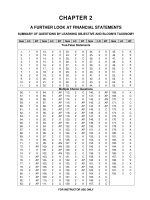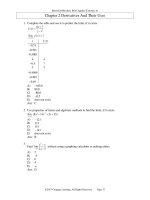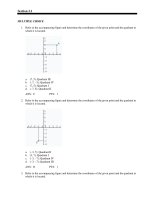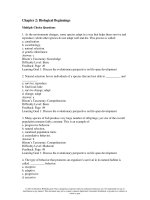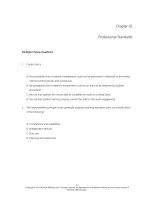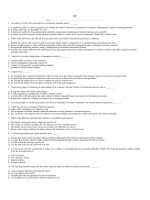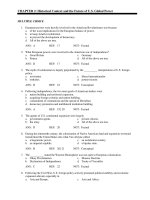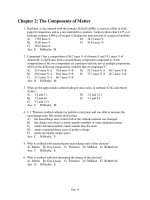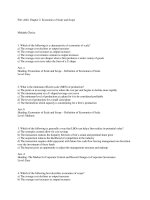Economics of strategy 6th edition besanko test bank
Bạn đang xem bản rút gọn của tài liệu. Xem và tải ngay bản đầy đủ của tài liệu tại đây (140.85 KB, 9 trang )
File: ch02, Chapter 2: Economies of Scale and Scope
Multiple Choice
1. Which of the following is a characteristic of economies of scale?
a) The average cost declines as output increases
b) The average cost increases as output increases
c) The average cost remains constant as output increases
d) The average costs are cheaper when a firm produces a wider variety of goods
e) The average cost curve takes the form of a U-shape
Ans: a
Heading: Economies of Scale and Scope – Definition of Economies of Scale
Level: Easy
2. What is the minimum efficient scale (MES) of production?
a) The point on an average cost curve where the cost per unit begins to decline more rapidly
b) The minimum point on a U-shaped average cost curve
c) The minimum level of production at a plant for it to be considered profitable
d) The level of production for a small sized plant
e) The threshold at which capacity is constraining for a firm’s production
Ans: b
Heading: Economies of Scale and Scope – Definition of Economies of Scale
Level: Medium
3. Which of the following is generally a way that LBOs can help a firm realize its potential value?
a) The synergies created allow for cost savings
b) The transaction reduces the disparity between a firm’s actual and potential share price
c) The acquisition reduces the likelihood of competition in the industry
d) The transaction requires debt repayment with future free cash flow leaving management no discretion
over the investment of these funds
e) The buyout gives an opportunity to adjust the management structure and makeup
Ans: d
Heading: The Market for Corporate Control and Recent Changes in Corporate Governance
Level: Easy
4. Which of the following best describes economies of scope?
a) The average cost declines as output increases
b) The average cost increases as output increases
c) The average cost remains constant as output increases
d) Savings are achieved when a firm produces a wider variety of goods
e) Savings are achieved when a firm produces a decreased variety of goods
Ans: d
Heading: Economies of Scale and Scope – Definition of Economies of Scope
Level: Easy
5. What measure, that depends on how much of a firm’s revenues are attributable to product market
activities that have shared technological characteristics, production characteristics, or distribution
channels, is used to determine how diversified a firm is at a given time?
a) Integration level
b) Rumelt score
c) Conglomerate level
d) Activity share
e) Relatedness
Ans: e
Heading: A Brief History
Level: Medium
6. Which of the following is not a product specific fixed cost?
a) The cost to manufacture a special die to make an aircraft fuselage
b) The cost of developing graphics software to facilitate video game development
c) The cost of a one-week training program preceding the implementation of a specific management
initiative
d) The time and expense required to set up a textbook before printing it
e) The cost of administrative expenses
Ans: e
Heading: Where do Scale Economies Come From? – Indivisibilities and the Spreading of Fixed Costs
Level: Medium
7. What kind of economies come from reductions in cost due to adoption of technology that has high
fixed costs, but lower variable costs?
a) Short-run economies of scale
b) Short-run economies of scope
c) Long-run economies of scale
d) Long-run economies of scope
e) Partially automated economies
Ans: c
Heading: Where do Scale Economies Come From? – Indivisibilities and the Spreading of Fixed Costs
Level: Hard
8. Examining which of the following is broadly considered one of the easiest ways to measure
diversifying activity?
a) Joint Ventures
b) Mergers and acquisitions
c) Internal Business Development
d) Strategic Alliances
e) Collaborative agreements
Ans: b
Heading: A Brief History
Level: Medium
9. What force does Manne indicate constrains the actions of managers so that they stay focused on the
goals of owners?
a) Market for corporate control
b) SEC
c) Corporate board
d) Corporate governance
e) CEO
Ans: a
Heading: Managerial Reasons for Diversification – The Market for Corporate Control and Recent
Changes in Corporate Governance
Level: Medium
10. What kind of economies come from reductions in average costs due to increases in capacity
utilization?
a) Short-run economies of scale
b) Short-run economies of scope
c) Long-run economies of scale
d) Long-run economies of scope
e) Fully automated economies
Ans: a
Heading: Where do Scale Economies Come From? – Indivisibilities and the Spreading of Fixed Costs
Level: Hard
11. What are economies of density as referred to in the airline industry?
a) Reducing the size of an aircraft used to increase load factor
b) Economies achieved by an airline flying from spoke to spoke in a hub-and-spoke network
c) Economies of scope along a given route
d) Economies of scale along a given route
e) Reductions in average cost as traffic volume decreases
Ans: d
Heading: Example 2.1 Hub-and-Spoke Networks and Economies of Scope in the Airline Industry
Level: Medium
12. Which of the following is not generally a potential benefit of diversification?
a) Control systems rewarding/penalizing division managers based on business unit objective
b) Economies of scale and scope
c) Economizing on transaction costs
d) Diversifying shareholder portfolios
e) Identifying undervalued firms
Ans: a
Heading: Why Do Firms Diversify? – Efficiency Based Reasons for Diversification
Level: Easy
13. Which of the following benefits of diversification explains the idea that mergers are more likely when
there is an expectation of positive changes in market share?
a) Use of internal capital markets
b) Economies of scale and scope
c) Economizing on transaction costs
d) Diversifying shareholder portfolios
e) Identifying undervalued firms
Ans: b
Heading: Why Do Firms Diversify? – Efficiency Based Reasons for Diversification
Level: Medium
14. How does carrying inventories contribute to economies of scale?
a) Increases the interest on the expenses to produce the inventory
b) Inventory depreciates in value while waiting to be used or sold
c) Increases the storage facilities necessary
d) Increases competition with rivals for customers
e) Minimizes the chance of stock-out
Ans: e
Heading: Where do Scale Economies Come From? – Inventories
Level: Medium
15. Which of the following benefits of diversification explains the idea that combining unrelated
businesses can allow firms to finance projects through cross-subsidization when they previously were
unable to finance the same projects externally?
a) Use of internal capital markets
b) Economies of scale and scope
c) Economizing on transaction costs
d) Diversifying shareholder portfolios
e) Identifying undervalued firms
Ans: c
Heading: Why Do Firms Diversify? – Efficiency Based Reasons for Diversification
Level: Medium
16. Which of the following is not a reason a supplier might seek to sell in bulk?
a) Each sale incurs a fixed cost in writing a contract
b) The purchaser is likely to switch over a small price due to the gains over the large number of units
ordered
c) Each sale involves setting up a different production run
d) The cost of delivery is a fixed on a per unit basis
e) The supplier fears uneven sales
Ans: c
Heading: Special Sources of Economies of Scale and Scope – Economies of Scale and Scope in
Purchasing
Level: Easy
17. How does umbrella branding aid economies of scale and scope?
a) Increases effectiveness of advertising due to a greater presence
b) Increases effectiveness of advertising due to national advertising
c) Increases effectiveness of advertising due to offering a broad product line under one name
d) Increased cost effectiveness through purchasing as a cooperative
e) Increased cost effectiveness through bulk purchasing
Ans: c
Heading: Special Sources of Economies of Scale and Scope – Economies of Scale and Scope in
Advertising
Level: Medium
18. Which of the following benefits of diversification explains the idea that a firm with many business
lines can reduce swings in value because it receives only a small percentage of its revenue from any one
of those business lines?
a) Use of internal capital markets
b) Economies of scale and scope
c) Economizing on transaction costs
d) Diversifying shareholder portfolios
e) Identifying undervalued firms
Ans: d
Heading: Why Do Firms Diversify? – Efficiency Based Reasons for Diversification
Level: Easy
19. Which of the following practices does not contribute to the strategic fit of Southwest Airlines?
a) No in-flight catering
b) Use of multiple types of planes
c) No use of congested airports
d) Re-engineered boarding process
e) No first class section on plane
Ans: b
Heading: Special Sources of Economies of Scale and Scope – Complementarities and Strategic Fit
Level: Easy
20. What type of research looks at the changes in market valuations in response to the announcement of
diversifying acquisitions to assess the success of diversification?
a) Event studies
b) Valuation studies
c) Diversification studies
d) Market studies
e) Acquisition studies
Ans: a
Heading: Performance of Diversified Firms – Valuation and Event Studies
Level: Hard
21. Which of the following is a source of diseconomies of scale at a large firm?
a) Labor costs
b) Spreading specialized resources too thin
c) Conflicts of interest
d) Incentive processes
e) All of the above
Ans: e
Heading: Sources of Diseconomies of Scale
Level: Easy
22. Which of the following benefits of diversification explains the idea that corporate diversification can
provide situations where an acquiring firm determines the stock price for firm they intend to acquire is too
low?
a) Use of internal capital markets
b) Economies of scale and scope
c) Economizing on transaction costs
d) Diversifying shareholder portfolios
e) Identifying undervalued firms
Ans: e
Heading: Why Do Firms Diversify? – Efficiency Based Reasons for Diversification
Level: Easy
23. Why might a large firm actually be at an advantage over a smaller firm with respect to labor?
a) Large generally pay a compensating differential to attract workers
b) Worker turnover is generally lower
c) Large firms enjoy better scale economies when negotiating with health insurance companies for health
benefits
d) Large firms are generally less attractive to qualified, upward mobile workers
e) Large firms often have to draw workers from a greater distance to fill their ranks
Ans: b
Heading: Sources of Diseconomies of Scale – Labor Costs and Size
Level: Medium
24. Which of the following is not a way managers generally benefit from acquisitions?
a) Increased compensation
b) Consolidation of other senior executives
c) Shielding against risk
d) Political power
e) Social prominence
Ans: b
Heading: Managerial Reasons for Diversification – Benefits to Managers from Acquisitions
Level: Medium
25. What is the approximate observed median learning curve slope for typical firms?
a) .6
b) .7
c) .8
d) .9
e) 1.0
Ans: c
Heading: The Learning Curve – The Concept of the Learning Curve
Level: Hard
26. Why is firm specific learning better in general for an organization?
a) Encourages individuality among workers within the organization
b) Keeps unionized workers happy
c) Allows workers to acquire skills they can then “shop around”
d) Ensures worker knowledge is tied to current employment
e) Increases complexity and creativity in the organization
Ans: d
Heading: The Learning Curve – Learning and Organization
Level: Medium
27. What institution within a firm must fail on some level for managers to be motivated to acquire another
firm for the purposes of increasing their own compensation, shielding themselves against risk, or gaining
prominence by running a larger firm?
a) Legal department
b) Corporate board
c) Mergers and acquisitions program
d) Firm bonus schedule
e) Corporate governance
Ans: e
Heading: Managerial Reasons for Diversification – Problems with Corporate Governance
Level: Hard
28. If a firm enjoys lower costs due to a complex labor-intensive process, which of the following
statements would then be true?
a) Cutbacks in volume will always raise unit costs
b) The firm is unconcerned with labor turnover
c) An example of this process could be the practice of anti-trust law
d) The firm’s average cost rises due to moving down the learning curve
e) The process is likely a repetitive manufacturing process such as two-piece aluminum can
manufacturing
Ans: c
Heading: The Learning Curve – The Learning Curve versus Economies of Scale
Level: Easy
29. By satisfying which of the following conditions can shareholders prevent management driven
acquisitions?
a) If shareholders could determine which acquisitions will lead to increased profits and which will not
b) If shareholders could direct management to undertake only those acquisitions that will increase
shareholder value
c) If shareholders could provide management with the appropriate steps to conduct when performing
acquisitions
d) a & b
e) None of the above
Ans: d
Heading: Managerial Reasons for Diversification – Problems with Corporate Governance
Level: Hard
Short Answer
30. Suppose the cost of producing a 30 second commercial for television is $100,000. If airtime on the
evening news costs $200,000 and is viewed by 5 million people, what is the advertising cost per potential
customer?
Ans: $.06 per potential customer, or $6.00 per 1000 customers
Heading: Special Sources of Economies of Scale and Scope – Economies of Scale and Scope in
Advertising
Level: Medium
